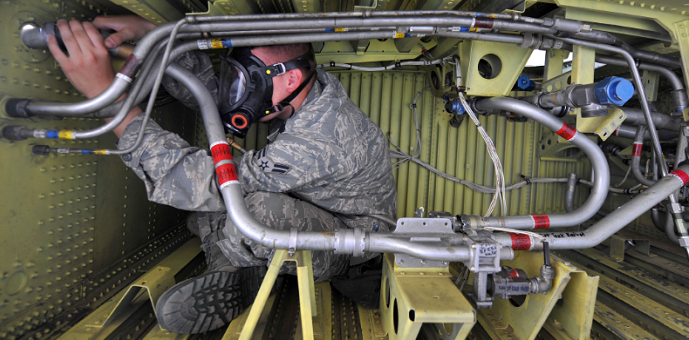Considering the role of a Fuel Tank Entry Team
An essential requirement to minimize exposure to the risk of injury during fuel-tank work is a properly trained and equipped team.
Personnel with authorization to enter the fuel tank and perform work must be able to recognize potential hazards and initiate evacuation if there are any concern issues
The following elements are critical to safe working conditions:
a) Communication.
b) Respiratory protection.
c) Ventilation and air monitoring.
d) Electrically powered tooling & equipment.
e) Aeroplane damage considerations.
Communications
Full-time voice communication must be maintained between the personnel who are working in the tank and the “Tank Buddy” who is standing by outside.
Note that the equipment used to support the voice communication must itself be approved for the environment in which it operates.
Respiratory Equipment
It is not always necessary to wear such equipment depending on the atmospheric hazards present.
Air-purifying respiratory systems should be used if the oxygen concentration is at 19.5 per cent or below.
If there is any potential for oxygen depletion to occur, or if chemical exposure levels are above the permissible exposure level (PEL), supplied-air respiratory protection should be required.
Always follow the specific guidance information and ensure that persons are fully training to use the equipment required and they are further aware of the safeguards and emergency procedures.
In any situation, safety or industrial hygiene professionals should be consulted for specific recommendations.
Ventilation and Ongoing Monitoring of Fuel Tank Environment
The air conditions of the tank should be continuously monitored throughout the tank entry process. If the oxygen concentration levels drop below 19.5 per cent or rise above 23.5 per cent, tank entrants should immediately evacuate the tank.
Additionally, If flammable vapour levels exceed 10 per cent of the LFL or if toxic vapour concentrations exceed the permissible exposure level PEL, tank entrants should evacuate the tank.
Fresh air should always be supplied to the fuel tank throughout tank entry process.
If for any reason ventilation is suspended, then tank entrants must evacuate the tank until the ventilation can be re-established.
Important Note
Pneumatic tools should be powered only by compressed air, not by nitrogen or other inert gas that could displace the oxygen inside the tank.
Electrical Tooling & Equipment
Any electrically powered lighting or equipment which is used in the fuel tank environment must be intrinsically safe or rated for use in a potentially flammable atmosphere.
Potential Damage Considerations
The possibility of accidental damage is real and all personnel working in the fuel tank environment must be properly trained
a) The mating surfaces of the access hole and covers should be protected during entry so that the surfaces are not scratched or otherwise damaged.
b) All components inside fuel tanks are also vulnerable to damage if they are struck or dislodged.
i/ fuel pumps,
ii/ fuel-quantity systems, and
iii/ associated wiring and conduits,
c) Finally, the containment properties of the fuel tank can be compromised if the sealant is damaged or dislodged or if fuel-tank bladders are penetrated.
Sofema Aviation Services www.sassofia.com and our sister online training portal Sofema Online www.sofemaonline.com offer both classroom and online (with voice-over) training compliant with the requirements of both EASA and FAA SFAR 88. For details please see our websites or email office@sassofia.com or online@sassofia.com




